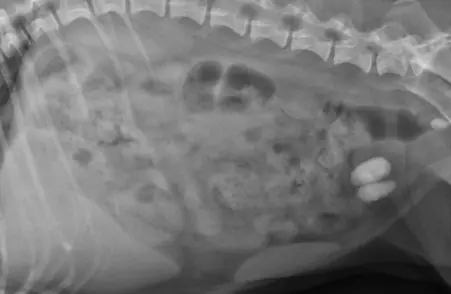[vc_row css_animation=”” row_type=”row” use_row_as_full_screen_section=”no” type=”full_width” angled_section=”no” text_align=”left” background_image_as_pattern=”without_pattern”][vc_column][vc_column_text]Molly is a 9 year old Shih Tzu presented to the WVS Animal Hospital just before Christmas with blood in her urine. Her urine test showed that she had a significant urinary tract infection and Molly was given a two week course of antibiotics.
When Molly came back for her recheck two weeks later, she still had blood in her urine. Dr. Lisa was concerned that Molly might have a bladder stone or tumour in her bladder that was causing the irritation and inflammation. A quick radiograph of Molly’s abdomen showed two large bladder stones.
It was decided that surgery to remove Molly’s bladder stones was in her best interest, so Molly underwent a cystotomy, a procedure to remove the bladder stones. Two large stones and many smaller ones were removed from Molly’s bladder.
Molly recovered well and within a couple of days was urinating normally, without any blood present.
Urolithiasis, or bladder stones are common in female small breed dogs. The cause behind their formation is not fully understood. Dogs with bladder stones can present with many different signs including blood in the urine, straining to urinate, increased frequency of urination, dribbling urine and tender abdomen. There are many different types of stones that can develop, with the majority being struvite or calcium oxalate.
To diagnose bladder stones, several diagnostic tests need to be performed. Firstly, the vet will examine a sample of your dog’s urine to check for infection, the presence of blood and white cells and the pH. A blood test is sometimes required to check kidney function. Xrays or ultrasound is used to confirm the presence of the stones.
Occasionally, struvite stones can be dissolved using a specifically designed diet, but most dogs will require surgery to remove the bladder stones. A urinary catheter needs to be placed to relieve and obstruction and flush the bladder during surgery. The stones are removed via cystotomy through an incision in the bladder.
Dogs that have had bladder stones have a high risk of recurrence. Therefore, these dogs need to be on a prescription diet lifelong to ensure optimal bladder health, and reduce the risk of recurrence.
Urine needs to be checked frequently after an episode of urolithiasis – this is initially done monthly, and then every three months for life. Checking the urine frequently allows your vet to assess for changes in the urine pH, and look for bacteria and crystals that may lead to the development of stones. Repeat radiographs or ultrasound will need to be performed if there are any abnormalities in the urine sample.[/vc_column_text][vc_separator type=”transparent” up=”30″]
[/vc_column][/vc_row]





